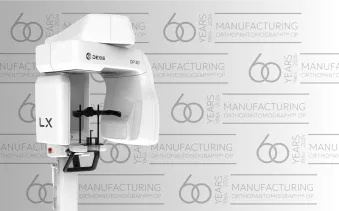
Wireless or Wired - Which Intraoral Scanner is Right for My Practice?
Choosing the right intraoral scanner for your dental practice can be a daunting task, especially when it comes to deciding between wireless and wired models. While wired intraoral scanners have been the industry standard for decades, wireless technology has improved considerably in recent years. To make the right selection for your practice, it is necessary to understand the differences between the two technologies and to examine how aspects such as practice size, number of sites, ease of mobility, budget, size and ergonomic comfort, and technology needs should be considered. In this blog, we will look at the advantages and disadvantages of wireless and wired intraoral scanners, as well as share some tips to help you decide which option is ideal for your practice.
Why should I choose a wireless intraoral scanner?
Wireless vs cabled equipment in dental practice has long been a point of contention. Because of their previous experiences with poor connectivity and low battery life, most dental offices have been hesitant to invest in wireless chairside equipment. Yet, because of extraordinary technological advancements driven by public demand, such as gaming wands and virtual reality systems, wireless technology is successfully being introduced into the dentistry industry.
Wireless intraoral scanners also provide various advantages over wired intraoral scanners, making them an attractive choice for dental practices. One of the most significant benefits is the flexibility of movement they allow. Dentists can move from chair to chair or room to room without having to worry about cords and cables getting in their way. This can help to make the scanning procedure more efficient while also making the patient more comfortable. For simplicity of use and handling, several wireless intraoral scanners, such as the DEXIS™ IS 3800W, are designed with a small and lightweight ergonomic wand. Additionally, the compact size of its battery charger means it will take up less room on the counter, freeing up valuable real estate. The IS 3800W scanner can be used with a laptop or installed on the IS Voyager mobile cart and wheeled from room to room, ensuring that the dental practitioner has access to all necessary data no matter where they are in the office. Wireless scanners, such as the IS 3800W, generally provide a more streamlined, convenient, and efficient scanning experience than corded scanners.
Are wireless scanners reliable enough for my dental practice?
Gone are the days when your mobile phone needs to remain on the charger all day to maintain battery life, and the IS 3800W intraoral scanner is no exception. The batteries are designed to provide approximately 1 hour of continuous scanning through 500 battery charging cycles after which the battery's charging power diminishes by 80%. At 6-8 full arch scans per charge, each battery can last for up to 3,000 – 4,000 scans.
Users of the IS 3800W scanner have stated that they can scan 6-8 dual, full arch patients on a single battery. Additional batteries can be purchased and charged using an optional battery charging device if required for practices with a high volume of scanning appointments.
The IS 3800W includes a backup power supply; in the case that all batteries are depleted, the backup power cable can be used to power the scanner, and the backup cable can be replaced with the battery once it has been recharged.
During scanning, the IS 3800W sends data from the handpiece to the computer through a USB WiFi adapter. The wireless connection has no impact on acquisition capability, so there is no difference in scanning acquisition speed between the wired IS 3800 and the wireless IS 3800W.
The absence of wires provides exceptional comfort and mobility without the inconvenience of dealing with tangled connections or the tension of cables that are generally connected to wired gadgets. Also, the lack of wires reduces the unpleasantness of having a cable stretched across a patient's body. Finally, because there is no cable, there is one less location that must be sterilized before use.
The mobility of wireless technology between treatment rooms is among the top benefits of the IS 3800W. Every workstation can be outfitted with a WiFi dongle, allowing the scanner to be easily moved about the clinic without the need to link it into a computer. This is extremely helpful for offices that keep their computers in furniture or cabinets, as there is no need to attach USB extension cords to access the connection point (and no worries about wires becoming loose inside the furniture over time). All that needs to be done is to move the scanner from room to room and activate it at the workstation in that location to begin scanning.
Why would I choose a wired scanner?
Wired devices are convenient and easy to use because they are typically plug and play. Because the scanner is powered by the computer, there is no need to be concerned about power loss due to battery depletion; if it is connected, it will be powered up. The IS 3800 scanner may be the right option for customers who do not want to monitor battery charging and replacement.
Furthermore, if your practice is in a building with congested wireless hotspots that could cause a disruption (as is the case with some medical facilities and high-rises), the direct USB connection provided by the IS 3800 may be a more reliable connection than the WiFi connection provided by the IS 3800W.
The IS 3800 scanner is significantly lighter than the IS 3800W, weighing only 190g as opposed to 240g (with battery) for the IS 3800W. If your clinic has a high volume of scanning visits, a lighter scanner may be the right solution.
The IS 3800 scanning device is also less expensive than the IS 3800W, making it an excellent choice for those looking for a high-performance scan at a low cost.
A disadvantage of using a wired intraoral scanner is that it must be powered from the connected PC, limiting mobility and freedom because the scanner is connected to the computer. Also, if the computer is installed in a cabinet, connecting and disconnecting the scanner when moving it from one location to another can be difficult. USB extension cables are available, although they may have an impact on the scanner's reliability, and the quality and functionality of the cables may vary depending on the manufacturer.
The IS Voyager and its accompanying IS All in One medical-grade computer, which can be easily transferred between dental treatment rooms, have provided a solution to the portability limitations often associated with wired scanners. This setup is compatible with both the IS 3800 and the IS 3800W.
Which Scanner Should I Choose for my Practice?
It is critical to make an informed decision when purchasing dental technology for your clinic. The IS 3800W wireless intraoral scanner and the IS 3800 wired intraoral scanner provide the same high-speed performance. The two main distinctions are the power source and the weight. The wireless version is powered by a battery, while the wired version is powered by a USB Type-C connection. Furthermore, the IS 3800W is the industry's lightest wireless scanner, weighing just 240g with the battery, while the IS 3800 is one of the lightest wired intraoral scanners, weighing only 190g.1
In order to assist practices in selecting the DEXIS IOS model and configuration that meets their needs, we have compiled the following table.
| Category | IS 3800W Wireless | IS 3800 Wired |
|---|---|---|
| Scanning range | Connection up to 20’ from computer | Tethered to the physical computer and limited to the length of the cable |
| Mobility | Both offer configuration with the optional IS Voyager configuration optimal mobility | Both offer configuration with the optional IS Voyager configuration for optimal mobility |
| Power source | Rechargeable batteries offer 1 hour of continuous scanning (6-8 dual full arch scans)
| Computer powers the scanner via a USB Type-C connection, so there is no need to manage battery discharge and eventual replacement |
| User ergonomics | Comfortable and easy to maneuver, with no cord drag | Comfortable, with some movements constraints due to cord drag, cord can twist and become tangled |
| Patient ergonomics | Absence of cables results in optimal patient scanning experience free of cable contact and interference | Cable can drag across patient’s arm, shoulder, or chest during scanning |
| Potential radiofrequency (RF) interference | Some concern in buildings with high-density wireless hotspots | Not an issue due to direct connection |
| Data acquisition speed | Both offer the same data acquisition speed | Both offer the same data acquisition speed |
| Disinfection | Fewer surfaces to disinfect as there is no cable | Scanner and cable require disinfection |
| Weight | One of the lightest wireless scanners in the market, weighing in at only 240g including the battery | One of the lightest intraoral scanners in the market, weighing in at only 190g (with tip, without cable) |
| Maintenance costs | Will need to monitor both tip and battery usage over time, tip will require replacement after 110 autoclave cycles while battery capacity drops to 80% after 500 charging cycles and will eventually require replacement | Need to monitor tip usage over time, replacing after 110 autoclave cycles. Detachable cable design allows for easy replacement should damage occur. |


